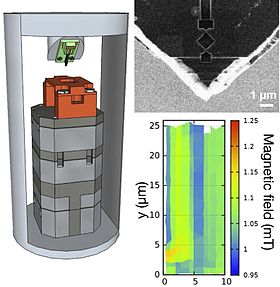
In condensed matter physics, scanning SQUID microscopy is a technique where a superconducting quantum interference device (SQUID) is used to image surface magnetic field strength with micrometre-scale resolution. A tiny SQUID is mounted onto a tip which is then rastered near the surface of the sample to be measured. As the SQUID is the most sensitive detector of magnetic fields available and can be constructed at submicrometre widths via lithography, the scanning SQUID microscope allows magnetic fields to be measured with unparalleled resolution and sensitivity. The first scanning SQUID microscope was built in 1992 by Black et al.[2] Since then the technique has been used to confirm unconventional superconductivity in several high-temperature superconductors including YBCO and BSCCO compounds.
- ^ Shibata, Yusuke; Nomura, Shintaro; Kashiwaya, Hiromi; Kashiwaya, Satoshi; Ishiguro, Ryosuke; Takayanagi, Hideaki (2015). "Imaging of current density distributions with a Nb weak-link scanning nano-SQUID microscope". Scientific Reports. 5: 15097. Bibcode:2015NatSR...515097S. doi:10.1038/srep15097. PMC 4602221. PMID 26459874.
- ^ Black, R.C.; A. Mathai; and F. C. Wellstood; E. Dantsker; A. H. Miklich; D. T. Nemeth; J. J. Kingston; J. Clarke (1993). "Magnetic microscopy using a liquid nitrogen cooled YBa2Cu3O7 superconducting quantum interference device". Appl. Phys. Lett. 62 (17): 2128–2130. Bibcode:1993ApPhL..62.2128B. doi:10.1063/1.109448.
© MMXXIII Rich X Search. We shall prevail. All rights reserved. Rich X Search
